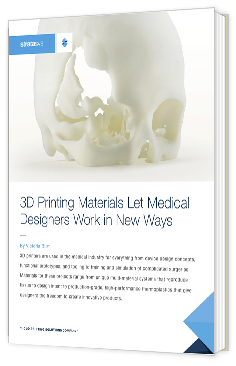

Tout ce que vous devez savoir sur les imprimantes 3D, cette technologie de pointe au service de produits innovants dans le secteur médical

3D Printing Materials Let Medical Designers Work in New Ways
"3D printers are used in the medical industry for everything from device design concepts, functional prototypes, and tooling to training and simulation of complicated surgeries. Materials for these projects range from unique multi-material systems that reproduce tissue to design intent to production-grade, high-performance thermoplastics that give designers the freedom to create innovative products.
3D printers take digital designs and make three- dimensional objects. The 3D printing process, also called additive manufacturing, builds parts
by depositing small amounts of material, layer by layer. Contrast this to traditional manufacturing methods that remove material by cutting, grinding, milling, and other methods.
There are several technologies used in 3D printers today. Fused Deposition Modeling (FDM®) and printing materials are discussed in this eBook. FDM, introduced in the early 1990s by Stratasys, builds 3D parts by melting and advancing a fine ribbon of plastic through a computer-controlled extrusion head, producing parts that are ready to use.
3D printing has been around for over 30 years but recently has gained a lot of media attention. Wohlers Associates Inc., a consulting firm that tracks developments and trends in rapid product development and additive manufacturing, expects worldwide revenue from the additive manufacturing and 3D printing industry to reach $12.8 billion by 2018. According to Wohlers Report 2015, the company’s annual publication on the subject, the industry grew to an estimated $4.1 billion in 2014. By 2020, Wohlers Associates forecasts revenues from all products and services in the industry to exceed $21 billion. The company attributes this growth to an increase in finished parts, the wider choice of machines and materials now available, media attention, investment across many groups, and low-cost desktop 3D printers."